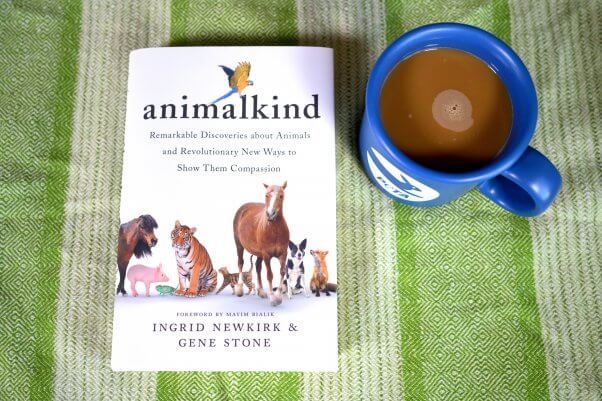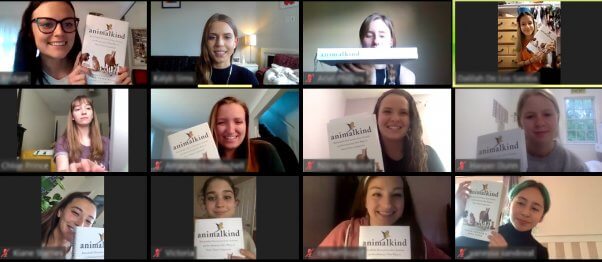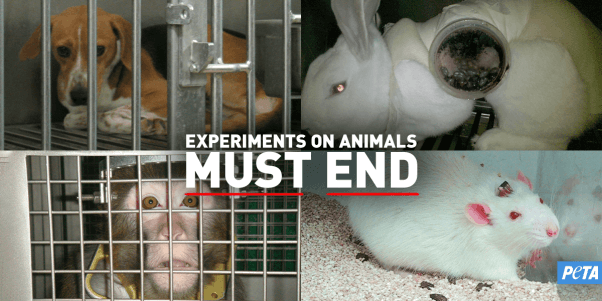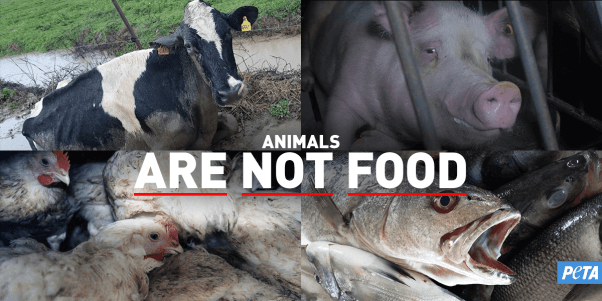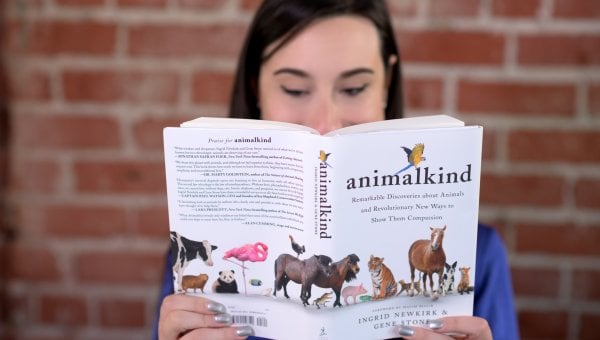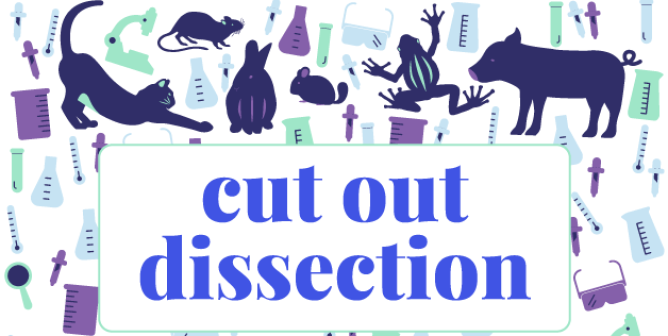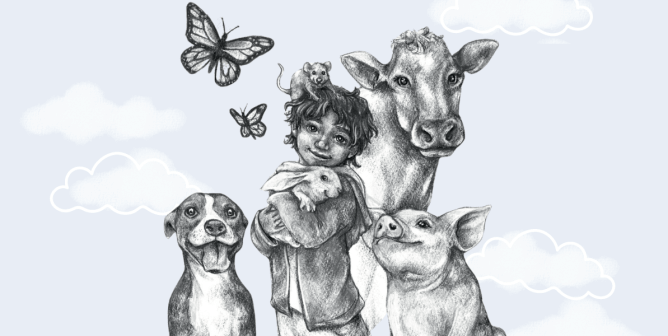Host a Student-Led Book Club Based on PETA President’s Bestseller ‘Animalkind’
Did you know that geese fall in love and stay with their partners for life? How about that fish “sing” underwater? Or that elephants use their trunks to send signals to other herds miles away, alerting them to danger?
Animals are much more intelligent, aware, empathetic, and creative than many humans give them credit for. A new book by PETA President Ingrid Newkirk and bestselling author Gene Stone aims to inform people and change their assumptions. Animalkind: Remarkable Discoveries About Animals and Revolutionary New Ways to Show Them Compassion gives readers astounding insight into the fascinating emotional lives of animals along with ways to show them the consideration and respect that they deserve.
Use the following guidelines to host a book club based on Animalkind—in person or virtually—for students in grades 6–12 and to address the following Common Core Learning Standards for Reading Informational Texts:
Grade 6
- Cite textual evidence to support analysis of what the text says explicitly as well as inferences drawn from the text.
Grade 7
- Cite several pieces of textual evidence to support analysis of what the text says explicitly as well as inferences drawn from the text.
Grade 8
- Cite the textual evidence that most strongly supports an analysis of what the text says explicitly as well as inferences drawn from the text.
Grades 9-10
- Cite strong and thorough textual evidence to support analysis of what the text says explicitly as well as inferences drawn from the text.
Grades 11-12
- Cite strong and thorough textual evidence to support analysis of what the text says explicitly as well as inferences drawn from the text, including determining where the text leaves matters uncertain.
Before Getting Started
Create a schedule. Animalkind is conveniently divided into two main sections, “Remarkable Discoveries About Animals” and “Revolutionary New Ways to Show Them Compassion,” both of which are divided into four subsections. Have students read and discuss one or two subsections a week, depending on your timeline and their ability. The following sample schedule can be adjusted to meet students’ needs.
Week 1: Foreword, Introduction, Section I—The Mysteries of Navigation, The Channels of Communication (pp. 1–61)
Week 2: Section I—The Intricacies of Love, The Joy of Play (pp. 62–112)
Week 3: Section II—Scientific Research, Clothing (pp. 113–180)
Week 4: Section II—Entertainment, Food, Afterword, Acknowledgments (pp. 181–241)
Establish expectations. Students should come to each meeting with a list of discussion items. This means that they must read actively. For some, that might mean keeping a notebook nearby as they read so that they can jot down questions and comments. Others might prefer to use sticky notes or a highlighter to mark noteworthy passages. If students aren’t sure what to look for as they read, provide them with the following annotation key to use in noting discussion items:
- A question mark (?) can be used to indicate anything that students have questions about.
- An exclamation point (!) can be used to indicate anything that grabs their attention or surprises them.
- A star (★) can be used to indicate an important passage.
- A heart (♥) can be used to indicate a passage that made them feel a strong emotion or one that they can relate to personally.
Students should also be prepared to take notes during the meetings. Explain to them that if they wish to respond to a comment made during a meeting, they’re not to interrupt—instead, they can jot down a note, wait for the classmate to finish, and then respond. This is an excellent opportunity for students to practice collaborative discussions that address speaking and listening skill standards. In addition to their notes, students can bring outside materials to the discussion, including relevant news articles, videos, and photos, to share with the group and inspire conversation.
If you’re teaching virtually, you can still host a book club using popular online conferencing tools like Zoom or Skype. If these tools aren’t available to you, you could have students chat about each week’s reading assignment in an online forum, such as Google Classroom. Designate a time frame during which students are to post at least one of their discussion items. Then have them give a thoughtful response to at least three of their classmates’ posts. Alternatively, you could start the conversation by posting a question.
During Meetings
Let students do most of the talking. Invite them to share the items on their discussion lists. Reassure them that they don’t necessarily have to say a lot because simply by pointing out a passage that they like or have a question about, they’ll likely prompt someone else to say something (who will then prompt someone else to say something, and so on). The only time you should step in is to do one of the following:
- Stimulate conversation (at the beginning of the meeting, during lulls in conversation, and at the end to wrap things up).
- Encourage quieter members to participate.
- Back up an unpopular opinion. It can be difficult to be the only one who loves or hates something, so it’s helpful for the teacher to say, “I agree. What made you feel that way?” or “I see what you mean.”
- Diffuse tension. If members are talking over one another or becoming combative, step in and encourage the group to relax and move on.
Be prepared with backup questions and conversation starters. Students may not come to each meeting with much to discuss, or they may be reluctant to share their thoughts. Start each meeting by asking what everyone thought of the week’s reading. Did they enjoy it? Did anything stand out? This alone may trigger conversation. But students could get through all their discussion items with time to spare. So if needed, use the following questions for each section to stimulate additional discussion:
The Mysteries of Navigation (pp. 15–37)
-
- Listen to Ingrid Newkirk read the story of Klepetan and Melena, starting on page 17. What makes their relationship so extraordinary?
- Describe the life cycle of the Pacific salmon, starting on page 24. How do scientists attempt to explain the salmons’ ability to return to the same rivers in which they hatched?
- Listen to Ingrid read about snails who travel great distances to return home, starting on page 31. How do humans find their way when they’re lost? Do you think you could find your way home without any assistance?
The Channels of Communication (pp. 38–61)
-
- According to marine biologist Phillip Clapham, humpback whales have “probably the most complex [songs] in the animal kingdom.” Listen to this clip and discuss it along with the passage about humpback whales on page 49.
- Do you think animals have no voice, or are humans just not listening? How can humans overcome this “language barrier”?
- Because animals don’t speak our languages, how can we interpret their body language to tell how they’re feeling and what they want and need?
The Intricacies of Love (pp. 62–87)
-
- Listen to Ingrid read about animals’ ways of finding mates, starting on page 67. What are some of the ways animals attract one another?
- Retell the story of Dolly the cow and her daughter, starting on page 76. Can you relate to this in any way?
- Take a look at this photograph of two geese sharing a goodbye “kiss,” described on page 81. Why do you think this image became an internet sensation?
The Joy of Play (pp. 88–112)
-
- Listen to Ingrid read about crocodiles playing, starting on page 109. Why does she write that “play wouldn’t seem to be a part of [a crocodile’s] life”? How can misconceptions like this result in harm to animals like crocodiles? Have you ever witnessed negative consequences that resulted from misconceptions about humans?
- Have you ever seen an animal play? Describe what you saw and how you think the animal felt.
- Do you consider playing and having fun to be a need (as opposed to a want)? Imagine what your life would be like if you were never allowed to have fun, just like many animals who are imprisoned for entertainment.
Scientific Research (pp. 119–154)
-
- Retell the story of Dr. Neal Barnard and his rat friend, Ratsky, starting on page 119. When he brought Ratsky home with him, what did he notice?
- Choose one of the cutting-edge, cruelty-free techniques from pages 132 to 137 that you find the most interesting. Explain why, and describe its potential to help animals.
- Which one of the actions discussed on pages 148 to 154 that people can take to speak up for animals used in experiments would you be the most interested in taking? Explain why.
Clothing (pp. 155–180)
-
- According to fashion historian James Laver, on page 158, what event in European history marked a major shift in the way people thought about clothing? Why? Is clothing made of animal-derived materials necessary for survival today? Should it be worn to make a fashion statement? Explain your answer.
- Which one of the clothing materials made without using animals discussed on pages 168 to 174 do you find the most interesting? Explain why, and describe its potential to help animals.
- Which one of the actions that people can take to speak up for animals used for fashion discussed on pages 174 to 180 would you be the most interested in taking? Explain why.
Entertainment (pp. 181-204)
-
- Why do you think that people who work with animals in the entertainment business often end up having a change of heart and advocating for an end to the use of animals in entertainment? For example, Alan Cumming advocates for Tonka, the chimpanzee who appeared in a film with him in 1997 (discussed on page 181); Ric O’Barry, who was a dolphin trainer for the popular 1960s television series Flipper, is now an ardent activist for dolphin freedom (discussed on page 186); and Richard Donner, coproducer of the film Free Willy, has said, “Removal of [orcas] from the wild for commercial purposes is obscene. … These horrendous captures absolutely must become a thing of the past.”
- Which one of the forms of entertainment that don’t use animals discussed on pages 193 to 199 do you find the most interesting? Explain why, and describe its potential to help animals.
- Which one of the actions that people can take to speak up for animals used for entertainment discussed on pages 199 to 204 would you be most interested in taking? Explain why.
Food (pp. 205–238)
-
- Early advocates for animals had relatively small followings and, in the case of Richard Martin (page 218) and others, were ridiculed for demanding that other species be protected from abuse and cruelty. But as of 2017, 6% of Americans self-identified as vegan (up from just 1% in 2014), and vegan restaurants and businesses are booming. Why is it important to challenge the status quo? Have you ever spoken out against something that was popular but that you felt was wrong? What happened?
- Which one of the foods made without animal-derived ingredients discussed on pages 220 to 234 do you find the most interesting? Explain why, and describe its potential to help animals.
- Which one of the actions that people can take to speak up for animals used in food discussed on pages 234 to 238 would you be the most interested in taking? Explain why.
After Completing the Book
Discuss the book as a whole. Pose the following questions to wrap up the reading:
- What’s one of your favorite stories or animal facts from the book? Why?
- What’s one new thing you learned from the book?
- If you could be any animal in the book, who would you be and why?
- Describe some of the similarities that all animals, humans included, share. Describe some of our differences.
- Do you find that your animal companions (or your friends’ animal companions) have keen navigational skills, communicate with others, display love and affection, and engage in play? How so? Have you ever observed other animals, such as squirrels, birds, and other wildlife in your neighborhood or in nature documentaries, doing these things? Explain your answer.
- Humans sometimes focus on all the amazing things that they can do that animals can’t. What are some amazing things that animals can do that humans can’t?
- Can we always explain why animals do what they do? Provide an example taken from the book of an animal’s behavior that humans don’t understand. Is our lack of understanding a good excuse for taking advantage of them? Explain your answer.
Apply the lessons that students have learned. Have students brainstorm ways that they can take what they learned from the book and apply it in their lives. For example, after learning that lab techs shave a bare patch on rabbits’ bodies and apply potentially harmful compounds to their skin in order to perform skin-irritation and allergy cosmetics tests—even though effective, animal-free testing methods already exist and are being used—students may decide to buy only certified cruelty-free products going forward. Use the following information, including pledges that students can sign, to inspire them to make compassionate lifestyle changes. Encourage them to keep their signed pledges and to display them in your classroom or in their home in a prominent location in order to remind themselves of their commitment:
- Pledge to go vegan.
- Pledge to buy exclusively cruelty-free products.
- Pledge never to go to a circus that uses animals.
- Pledge to go down-free.
- Pledge to go leather-free.
- Pledge to go fur-free.
- Pledge to speak up for “backyard dogs.”
Additional Suggestions
- Watch and discuss Ingrid Newkirk’s virtual “Animalkind” talk.
- Have students watch this video about crabs titled “‘Animalkind’: Animals Are Awesome, and Crabs Are Clever,” and follow along using this guide.
BLOCK_MULTI_2 - Get a copy of Animalkind into your school or local library.
- Invite students to bring a vegan snack and drink with them to each book club meeting.
- Challenge another teacher to host a student-led book club based on Animalkind.
- To supplement your reading of Animalkind, if you’d like to use a video (in English or Spanish)—featuring Ingrid herself—that was created for students, please contact us at [email protected].

